Every forensic document laboratory and agency has a set of instruments and tools that serve as the backbone and provide trustworthy data that can easily be admissible in a court of law.
The following are the tools used by Forensic Document Examiners (FDEs) to evaluate questioned documents. The majority of devices are regularly utilized in the production of a QD analysis report. However, some of them are also uncommon. Let’s have a look one by one.
| S.No. | QD Instrument/Tool | Forensic Uses |
|---|---|---|
| 1. | Measuring Rulers and Grids | precise measurements of documents |
| 2. | DSLR 35mm/Medium Format Camera | documenting evidence |
| 3. | Duplicating Devices | replicate documents physically or digitally |
| 4. | Microspectrophotometer | accurate analysis of color shades |
| 5. | Spectrophotofluorometer | characterization of inks and security papers |
| 6. | Paper Brightness Tester (TAPPI &, ISO) | determine the brightness of paper |
| 7. | Glossmeter | how glossy a paper is; in gloss meter |
| 8. | Opacimeter | how much a paper is translucent. |
| 9. | Analytical Weighing Machine | weighing measures |
| 10. | Dead Weight Thickness Micrometer | thickness of paper |
| 11. | Typewriter Measurement Plate | to define pica or elite typewriters |
| 12. | Handheld & Assorted Magnifiers | simple magnification device |
| 13. | Optivisor and Comparator | magnification devices |
| 14. | Stereoscopic Microscope | 3d view with 50x magnification power |
| 15. | Comparison Microscopes | side by side comparison |
| 16. | Scanning Electron Microscopes (SEM) | SED (x400), BSD, and emitted x-ray analysis |
| 17. | Optical Watermark Detector | analyze and detect stamps forgery |
| 18. | Video Spectral Comparator (VSC) | multiple optical observation spectrum |
| 19. | Electrostatic Detection Apparatus (ESDA) | decipher indentation writing |
| 20. | Raman Spectrometer | fast and selective chemical ink analysis |
| 21. | Olfactory Port Detector | detect VOCs for age estimation |
| 22. | X-ray Diffraction Techniques | detection of crystalline paper additives |
| 23. | Spectroscopy Measuring Instruments | trace elements, age estimation |
1. Measuring Rulers and Grids
Rulers, gauges, and grids are some of the measuring devices used to determine the precise measurement of questioned documents.
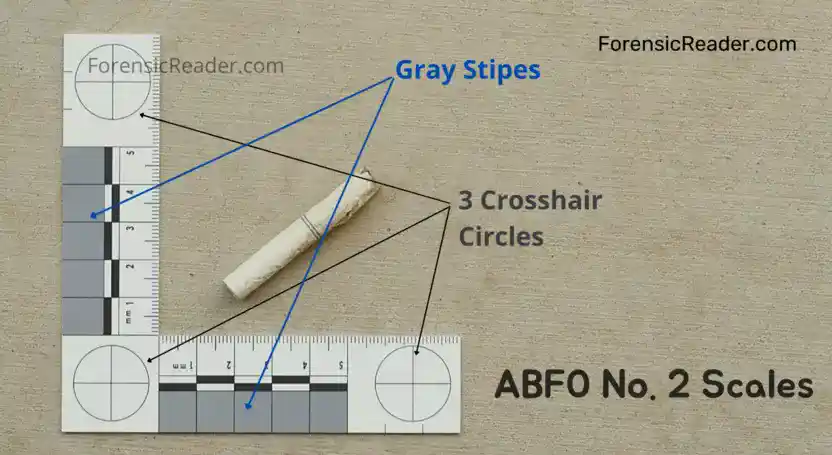
Ruler: Regular 6 and 12 inches scale with clear plastic or glass, and opaque paper or metal body. Used to measure the dimension of QDs. Opaque paper, metal, and wood scales are used to document the actual size while photographing.
Grids: Having grids on a plastic sheet makes it perfect for tracing the area. Used to analyze the graphology of signature and handwriting along with stamp marks.
Reticle: When a flat circular glass has a measuring metric on the bottom that assists in measuring fine details is called a reticle.

2. DSLR 35mm/Medium Format Camera
The most suitable camera for QDs is a high-quality DSLR camera with 35mm or medium format. These cameras are coupled mainly with a couple of lenses for normal (50mm), close-up, and wide-angle photography (17-35mm) and telephoto lens (70-200mm).
Among all, close-up photography is majorly equipped. It replicates clear, close-up photographs of questioned documents which are later enlarged to view the writing characters and give a more detailed examination than the paper itself.
How to take QD photographs? Place the camera lens perpendicular to the document on a tripod stand and snap a photo in a proper lighting condition. The Tripod stand gives a stable hand to the camera eliminating any chance of distortion.

3. Duplicating Devices
Apart from a high-resolution camera, a photocopier and scanner are employed to replicate the detailing on physical paper and digitally.
Photocopier: They are not restricted to replicate 1-on-1 size copies. The enlarged photocopied provides an extensive detailing of a part of the document. They can even be used in representing the evidence in court, and multiple copies for juries, if any.
Scanner: Capture detail with a specific resolution. Any scanner for forensic purposes should capture at least 300 dpi. And for more engagement, 600 dpi is good. Going beyond 600 dpi is usually not employed to document examinations. Plus, later the cropped or enlarged images can be printed with inkjet and laser printers.
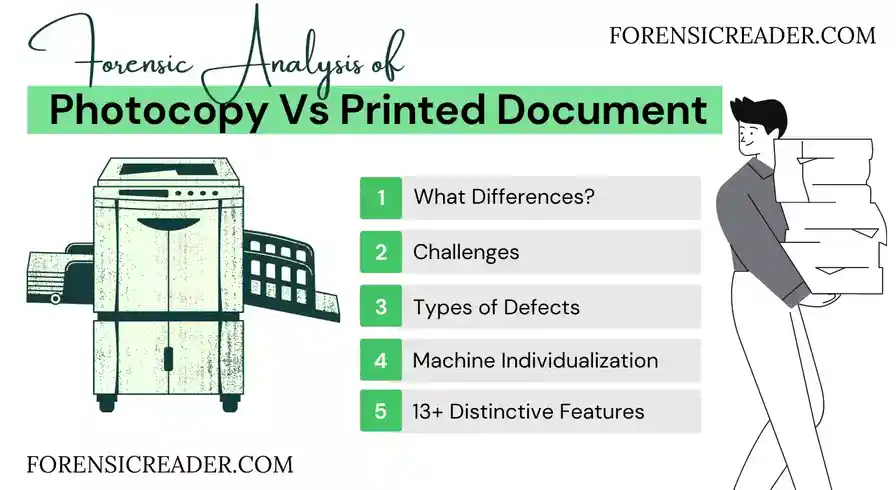
4. Microspectrophotometer
As a forensic expert, you can’t simply go to court and say, “Both the questioned and reference samples have the same colors.” You must prove it.
For this visible spectral reflectance spectroscopy (microspectrophotometer) comes into play. It is used to define different colors on an object.
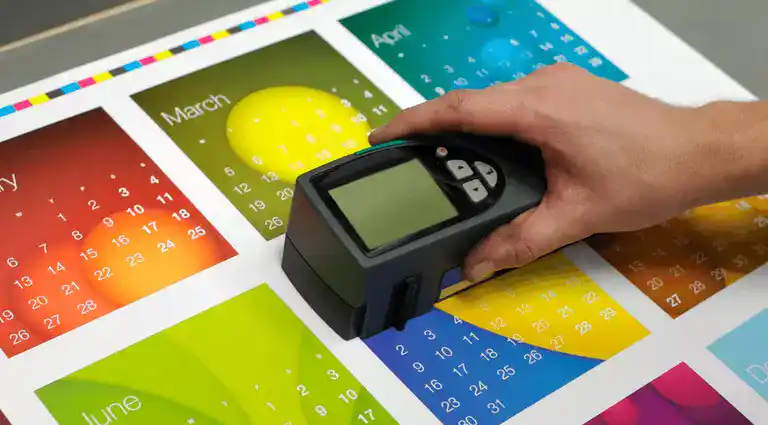
Using it, a forensic document examiner can even differentiate the slightly different shades of paper color. And even different shades of dye are being used to make the papered document.
The principle is based on the absorption or transmission spectrum on a paper by either transmitted or reflected light.
5. Spectrophotofluorometer
The sample is projected with an illuminated xenon flash lamp and measured the fluorescent light emitted from the sample at different wavelengths. Common fluorescent color signals (wavelength) are green and blue, or blue and ultraviolet.
In the questioned document, a fluorometer is applied extensively in the characterization of inks and special security papers.
Other non-QD applications are the analysis of drugs, glass, petroleum products, biological samples, and fluorescent dyes for visualizing fingermarks.
6. Paper Brightness Tester (TAPPI &, ISO)
The amount of blue reflected by paper at a wavelength of 456 nm defines how bright a paper is. To make paper brighter, paper manufacturers use Optical Brighteners Agents (OBAs) that emit invisible UV rays into visible blue light.
For measuring paper brightness two measuring techniques: TAPPI and ISO.
- T452: Uses TAPPI metrics and the sample is analyzed using a single projection and reception of source and detector.
- ISO Brightness Tester: Uses ISO metrics. Paper is placed in highly reflective non-glossy internal walls fitted with a photocell receptor.
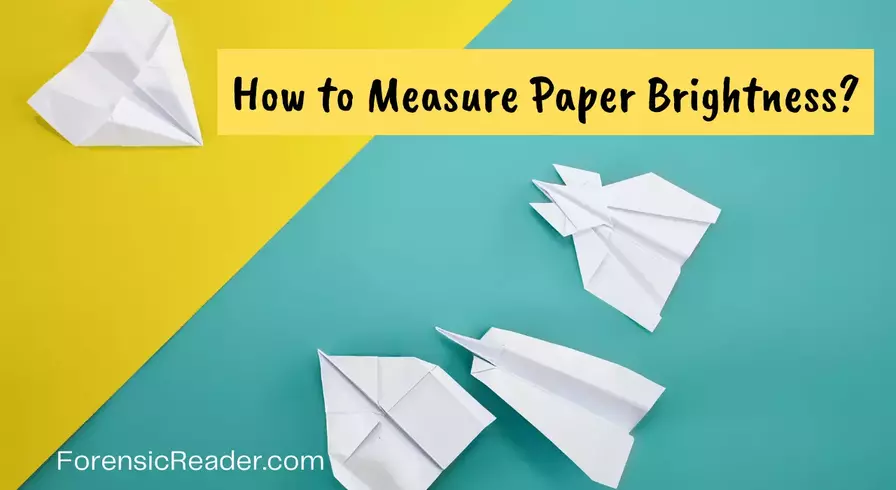
7. Glossmeter
This forensic tool is used to determine the glossiness of a paper. The principle of a gloss meter is based on the ratio of reflectance to falling light from a paper sample.
Procedure: While analyzing, a source of light of fixed intensity is projected at a fixed angle and measures the amount of light reflected at an opposite angle. For each sample, measurement is done at 20°, 60°, and 85° with a highly polished reference black glass standard.
Measuring Units: Gloss units (GU). Ranges up to 100GU.
A sample can be categorized into 3 types based on glossiness characteristics based on a specific angle.
- High Gloss: 70GU or higher
- Medium Gloss: 70 to 10GU
- Low Gloss: Less than 10GU
Read More: Forensic Analysis of Paper: An Informative Guide to Paper Forensic
8. Opacimeter
It defines how opaque a paper is. It can also be evaluated based on the extent of ink visible on the other side of the paper.
An Opacimeter uses contrast ratio and diffuse method to compute the amount of light a document, usually, paper can transmit through it.
In the contrast ratio method, the ratio of the amount of light reflected back by a paper with two distinct standard backgrounds i.e. black and white. While diffusion method is defined as the ratio of light reflected back through a paper with a black background to stacks of papered sheets.
9. Analytical Weighing Machine
An analytical weighing machine with milligram scales is used to calculate the grammage (gsm) value of paper. A grammage (gsm) is defined as the weight of paper in grams/sq.meters.
Most of the common papers are available in 35 to 120gsm. The higher the paper, the thicker and heavier it is, at a specific dimension.
Follow the steps to calculate the gsm values. (1) Find the paper dimension (mm) and weight (grams) of a single sheet. (2) Calculate the area (3) Calculate Factor value= 1/area (4) Gsm value= Factor value x weight
And if two general office paper sheets have more than 10% variation, they should be considered as two different sheets.
Know More: Jump to the Basis Weight (Grammage) of Forensic Paper Analysis
10. Dead Weight Thickness Micrometer
Because paper is so thin, a special tool called a deadweight thickness micrometer is used to measure the thickness in micrometers (µm).
Furthermore, the thickness can help in calculating the probable weight of the paper in cases of fragmented, shredded, and partially burned papers.
Instruments working: A deadweight thickness micrometer has a circular wide diameter foot with a platen base on which the sheet is placed. While analyzing the sample, the weight-foot should rest for 2 to 5 seconds under a pressure of up to 98 Kpa.
Steps to be followed: (1) Calibrate the machine using a standard A4 sheet. (2) Measure at least 10 points of the sheet. (3) Take the average and values in micrometers (µm).
11. Typewriter Measurement Plates/ Grids
To document the number of characters per inch a typewriter can register, a standard typewriter measurement plate or grid is used. In general, there are two types of typewriting instruments: one is pica and the other is elite.
Pica typewriters share 10 characters per inch (cpi) while elite type 12cpi. Here is the image….

During measuring, the gauge needs to be accurate because even an error of 1/25 of an inch can misinform the value. As modern fonts such as Gothic, and Courier, come in different sizes they require additional size grids.
You can buy a typewriter measuring plate on Sirchie.com or forensi-tech.com
12. Handheld Glasses and Assorted Magnifiers
Handheld glasses are limited to single-lens magnification. Their magnification power can range from 2x to 10x. The build usually has a single concave lens with or without assisting lights.
Note: Power refers to the multiple magnifications of the normal site. In a general sense, 3 Power= 300% enlargement.
High-power lenses, such as 8x to 10x power are satisfactory for handwriting analysis because the letter construction and ink flow can easily be made visible.
While, low power lenses, such as 2 or 3x, aid a forensic document examiner (FDE) in analyzing every small detail that would otherwise be difficult to see clearly. It will become a general tool for FDEs who will have difficulty in observing due to aging.
Assorted Magnifiers: They are just magnifying glasses with a powerful light source. It comes with a 2 to 8x power range.
Note: In any Forensic Document Unit (FDU), any QD is analyzed primarily using imaging and replicating techniques. Hence, their photographic version or scan copies are preferred because they produce more resolute high-zoomable images.
13. Optivisor and Comparator
Optivisors are lightweight magnifiers with assisting bandages to hold filmy on examiner eyes or their eyeglasses. This question document tool gives the examiner both free hands during the examination. Plus, if the examiner needs more enlargement, they can even couple an optivisor with handheld glasses.
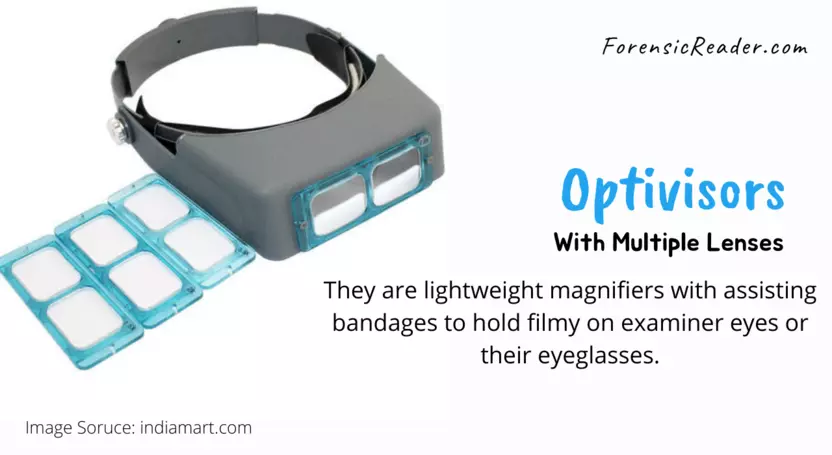
Comparator: A magnifying glass with a reticle for measuring small distances. The reticles in the comparator are detachable and repealed with various other measuring systems such as linear scales and angles.
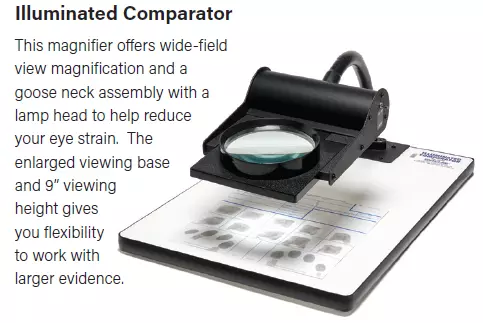
14. Stereoscopic Microscope
A stereoscopic microscope provides a low-magnified three-dimensional view usually ranging from 10 to 50 power, fitted with both incident and transmitted illumination.
The 3D viewing allows FDE to examine the questioned document sample in greater depth, such as pressure patterns, erased and intended writing, overlapping and sequence of writing strokes, and so on.
Types of Stereoscopic Microscopes
For availability, they can be classified by different lenses on an objective turret (single or dual power) or a zoom lens.
In a single stereo microscope, it has a single built-in objective lens of power 2x or 3x with a changeable magnified eyepiece. Whereas in a dual-power stereoscopic microscope, objective lenses are powered at two magnification values (15x and 45x or 10x and 30x) with a magnifying eyepiece.
Conversely to both constantly powered lenses, in a zoom stereo microscope, an examiner can adjust any magnification value between 10 to 50 power that gives a continuously variable range. But they cost nearly twice as much as the other two.
Additionally, a compact and portable stereo microscope is the first choice in modern crime scene investigation kits.
Note: Multistation tally course is an add-on to the stereo microscope in fiber and pulp analysis. The instrument is used for counting fibers based on their morphological observations.
15. Comparison Microscopes
A comparison microscope has a side-by-side view to analyze two samples through a single lens. They can be broadly divided into two categories: (1) Vertical line and (2) Full-field comparison method.
In Vertical comparison microscopes, the observation field is divided into two at a vertical line— each sample has one side. This enables a close comparison side by side and lacks the superimposition of two areas. Used for comparison of cartridges, bullets, and fibers.
For document analysis, a superposed image view is employed with an incident source that flashes light at a constant rate. It can also be called a stroboscopic microscope. For broad-spectrum analysis, incident light of different colors or illumination can be employed.
Here, the rate of strobing characterized paper questioned document by:
- Flickering off and on features present on documents, or
- The apparent movement of a feature differs in position between the two documents.
They are outdated as most of the alternative light analysis is done by VSC and superimpositions are done by various imaging tools.
16. Scanning Electron Microscopes (SEM)
SEM offers a higher resolution image of up to 100,000x with a greater depth than any other laboratory optical microscope. Instead of projecting a light spectrum, SEM uses an array of electrons to scan the document line by line (or frame).
When the electron hits the sample, secondary electrons, backscattered electrons, and x-rays emitted as complementary products.
a. Secondary Electrons Detector (SED): Displays the topography of the questioned documents or any other specimen on a monitor. It is usually restricted to a max 400x resolution— as FDE doesn’t require more than 400x magnification. Common use in QD examination: sequence of writing, identifying dry-transfer lettering and photocopies material
b. Backscattered Electron Detector (BSD): Characterize the elemental analysis by reflecting the atomic numbers. Used mainly for differentiating inks of the same color but different chemical compositions, and for analyzing underneath of the altered writing that is opaque to IR.
c. Emitted X-ray Analysis: Provides quantitative information about the elemental composition of the sample with an element number more than Sodium. Used for analysis for printing and security inks and mineral components of the paper. Not useful for ballpoint and water-based inks because their chemical components can’t be detected by X-ray spectrometry.
17. Optical Watermark Detection Apparatus
Specifically designed to analyze and detect forgeries in stamp watermarks. The principle of the apparatus is an optical observable variation of multicolored marking that fluoresces differently in an alternative light. This makes it fairly advantageous for questioned documents such as security notes, stamps, and banknotes.
However, traditionally watermarks (slightly less opaque than paper) don’t have multiple shades of color hence not useful. And here VSC seems more advantageous.
Additionally, in forensic questioned document laboratories, an optical watermarks detector is widely replaced by a VSC. This is because VSC offers more room for sample placement and observation.

18. Video Spectral Comparator (VSC)
VSC is a non-destructive examination of document evidence under a wide range of the spectrum. It is incorporated with a wide spectrum light source, filters, lenses, a visual display unit, and IR-sensitive charge-coupled device (CCD) cameras. Mostly VSC is employed with radiant energy in infrared, visible, and UV.
Additionally, VSC is a type of Video Spectral Analysis (VSA), and the other one is Filtered Light Examination (FLE). With FLE, the examiner can provide a far wider spectrum with a different wavelength than VSC.
However, some modern models of VSC— by Foster & Freeman— include analysis samples in near-infrared radiation (IRR) and infrared luminescence (IRL). This enables a more detailed analysis of ink and restoration capabilities. Many others offer image enhancements, on-screen displays, and printing capabilities.
Forensic Use: VSC for detecting alteration, security features, optical ink properties, differentiating pencil with ink writing, restoration, secret writings, etc.
Common available VSA manufacturers are:
- Video Spectral Comparator (VSC) from Foster & Freeman Ltd. (UK)
- Docubox HD from Projectina AG (Switzerland).
19. Electrostatic Detection Apparatus (ESDA)
Electrostatic Detection Apparatus (ESDA) of Electrostatic Detection Device (EDD) uses paper dielectric properties to present the imprisoned marking over the papered document.
In general considerations, ESDA comprises main three parts;
- Porous flatbed: A usually porous brass bed to evacuate air
- Thin transparent plastic film holder.
- Corona discharge unit: A wire to charge the film with about 8kV.
How does it work?
- Document if placed on the flattened bed covered
- Plastic film is applied
- Vacuum and evacuate the air
- ~8kV charge is applied
- Develop an imaging film (visible impression)
- Application of photocopy toner powder to the surface (makes it more contrasted).
And, one of the most common ESDA manufacturers is Foster and Freeman Ltd.
20. Raman Spectrometer
Though most of the spectroscopy analysis is performed in VSC, the Raman spectrometer provides fast and selective chemical analysis of ink.
With apparatus like those made by Foster and Freeman called Foram 3 Raman spectrometer gives a fast non-destructive ink analysis on paper and security documents. Some highlighting features are variable laser wavelengths, quick analysis, and results along with video imaging.
One of the major drawbacks of using Raman spectrometers is the low sensitivity and overwhelming phenomenon of fluorescence.
21. Olfactory Port Detector
You can be called to be the sniffing dog’s machine. Except they provide logical scientific data on the odor possessed by a forensic document.
An Olfactory detector detects odor dilution from the sample. It is based on the fact that every paper has some odor in the form of volatile organic compounds (VOCs), which can be traced back to the original manufacturer and constituents used for the manufacturing.
And, as paper ages, the odor intensifies, indicating a close relationship between age and the components that affect paper degradation.
Usually, olfactory detectors are compiled with GC-MS Static Headspace with an Olfactory Detector Port. First, the sample is introduced in GC for separation and the resultant is split between MS (molecular weight of component) and Olfactory detector (odor analysis).
Uses: Majorly used for the authentication of paper and old books for a century.
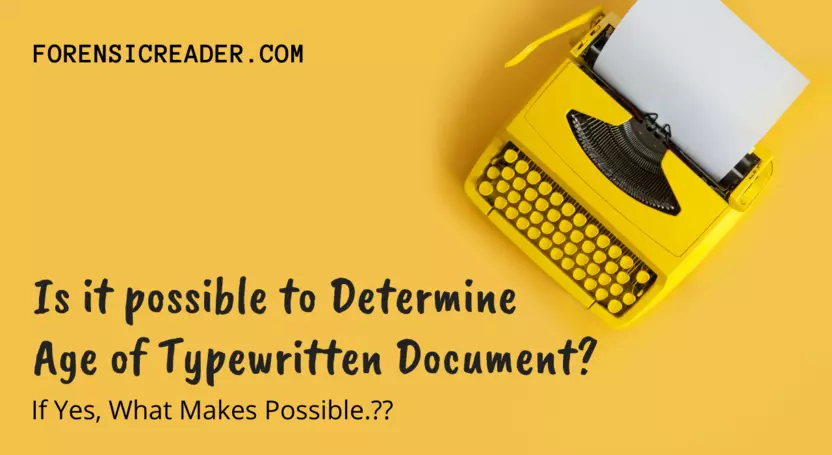
22. X-ray Diffraction Techniques
It is based on constructive interference of monochromatic X-ray beams with the crystalline structure of the sample.
Specifically, in forensic document analysis, X-ray diffraction identifies the paper additives and fillers with pigmented crystalline structures such as kaolin, titanium dioxide, talc, clay (quartz), mica, calcium carbon, and calcium sulfate.
Another instrument called X-ray Excited Optical Fluorescence Spectrometer (XREOF) has a special application i.e. identification of ink tags by producing a highly selective and individualistic line of emissions.
Note: In 1968, the US Bureau of Alcohol, Tobacco, and Firearms (ATF) initiated the development of a library of ink for identification and dating.
23. Spectroscopy Measuring Instruments in QDs
Most of the spectrum-based spectroscopic analysis is covered in VSC analysis. But, here are some spectroscopic measuring tools that are used in questioned document analysis.
Fourier Transform Infrared Spectroscopy (FTIR): used for the determination of some paper additives such as kaolin as well as paper coating materials sources such as plasticizers, solvents, and inorganic pigments.
Mass Spectroscopy (MS), Neutron Activation Analysis (NAA), and Atomic Absorption (AA) are commonly employed for trace elemental analysis.
Two other instruments specifically for age estimation are; (1) Accelerator Mass Spectrometry (AMS) by carbon dating, and (2) Small-Angle Neutron Scattering (SANS) by measuring nano-sized water-filled pores of cellulose fiber with time.
Continue Reading:
- Why is it Not Advisable to Lift Fingerprints from Paper?
- Forensic Casting Materials: How to Choose One For Different Surfaces?
- 14 Myths of Fingerprints And Questioned Documents: A Forensic Study
- Identification of Paper Additives: Fillers, Oil, Waxes, and Pigment
- Forensic Paper Fiber and Pulp Analysis: How They Impact Questioned Documents Examination

FR Author Group at ForensicReader is a team of Forensic experts and scholars having B.Sc, M.Sc, or Doctorate( Ph.D.) degrees in Forensic Science. We published on topics on fingerprints, questioned documents, forensic medicine, toxicology, physical evidence, and related case studies. Know More.
